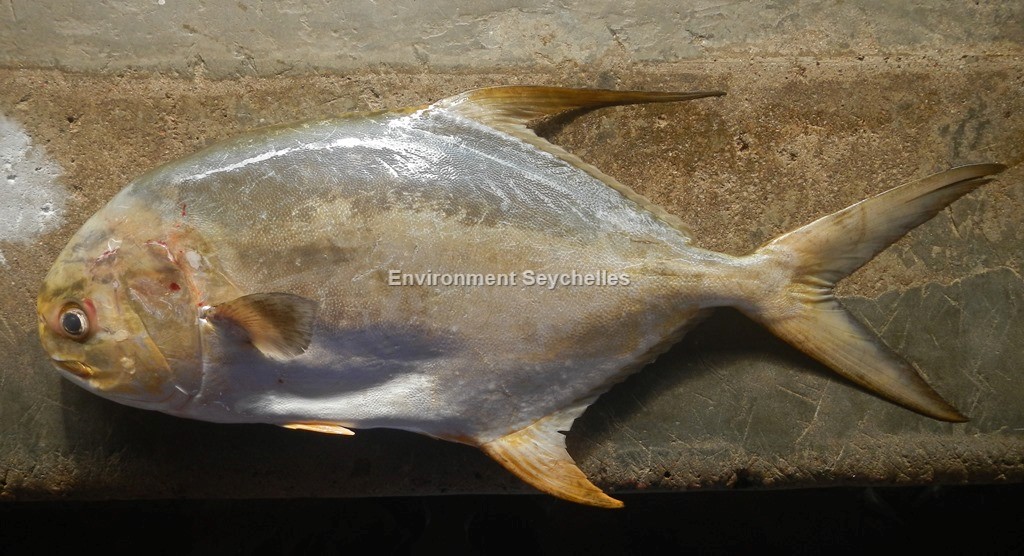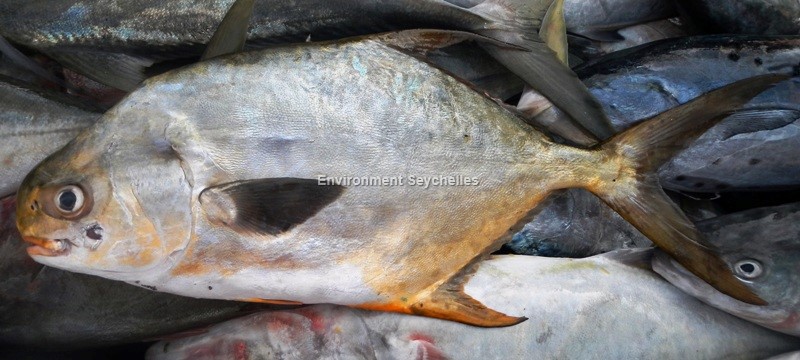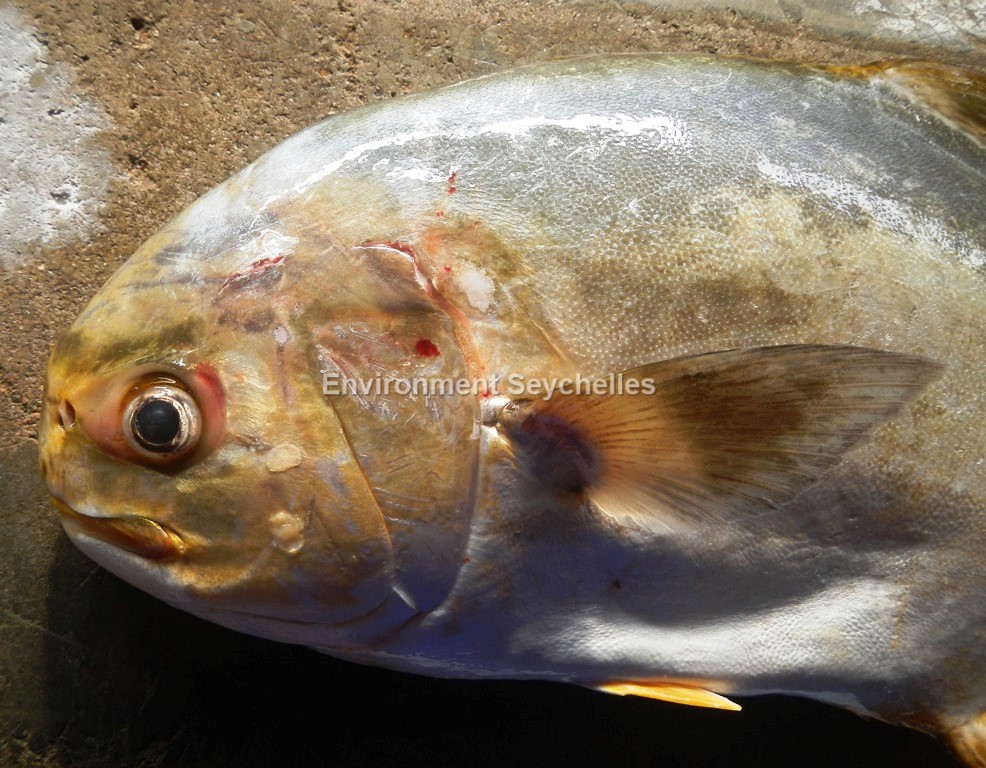Description:
Dorsal spines: 7; Dorsal rays: 18-20; Anal spines: 3; Anal rays: 16-18.
Robust fish, moderately compressed with deep ovoid body. Profile of snout broadly rounded, in adults becoming nearly straight to interorbital region. Mouth is positioned
just below the bluntly rounded snout, both jaws with bands of small villiform teeth. Covered in numerous small scales except the head region which is naked. Lateral line
slightly irregular, weakly convex above pectoral fin, becoming straight posteriorly. Anal and dorsal fins have long falcate lobes. The caudal fin is large and deeply
forked, and the pelvic fins are shorter than the pectorals.
Colour. Head and body generally silvery, blue grey above, paler below. Sometimes with a golden-orange tinge, especially on snout and lower half of body. Second dorsal
fin dark, lobe of fin dusky orange. Anal fin dusky dirty orange, lobe with a brownish anterior margin. Caudal fin dark to dirty orange with leading edges of fin darkest.
Pelvic fins white to dirty orange, pectoral fins dark. Juveniles are silvery with pale fins, except for brownish to brownish-orange lobes of median fins and anterior half
of pelvic fins.
Size:
Maturity: Lm unknown. Range unknown. Max Length: 65 cm TL. Commonly 40cm TL.
Habitat and Ecology:
Inhabits shallow, coastal waters over coral and rocky reefs (depth 1-7m). Occasionally observed in small schools. Diet consists mainly of bivalve molluscs that live in the
sandy surf zone and other hard-shelled invertebrates. Uses strong pharyngeal teeth to crack shells.
Fishery Status:
This species is not protected or subject to fishery regulations. It is caught in the handline and net fisheries where it is a regular but not frequent or abundant component of the catch.
Notes:
References:
Bray, D.J. (2017). Trachinotus blochii in Fishes of Australia, http://fishesofaustralia.net.au/home/species/2993 (22/05/19).
FAO 2016-2019. Cultured Aquatic Species Information Programme. Trachinotus spp. http://www.fao.org/fishery/culturedspecies/Trachinotus_spp/en (21/05/19).
Froese, R. & D. Pauly. (Eds.) (2019). FishBase. https://www.fishbase.se/summary/Trachinotus-blochii.html (21/05/19).
McGrouther, M. (2018). Snubnose Dart, Trachinotus blochii (Lacépède, 1801). https://australianmuseum.net.au/learn/animals/fishes/snubnose-dart-trachinotus-blochii/ (22/05/19).
Smith-Vaniz, W.F. & Williams, I. (2016). Trachinotus blochii (errata version 2017). The IUCN Red List 2016: http://dx.doi.org/10.2305/IUCN.UK.2016-3.RLTS.T20436497A46664144.en. (21/05/19).
Citation:
Nevill, J.E.G. (2019). Trachinotus blochii, Snubnose pompano. Seychelles Seatizens. www.seatizens.sc. https://seatizens.sc/species/trachinotus-blochii-lacepede-1801/ (edited 27/06/22).




Thanks again for the post.Much thanks again. Keep writing.
Thank you. Excellent information!
best online casino canada best online casino sites canada jackpotcity casino canada
Truly loads of amazing data!
best online casino canada real money https://hotgamblingguide.org/online-casinos-in-canada/ canadian casino
I value the article post. Will read on…
Whoa tons of terrific facts!
play milky way casino online bet online casino ac casino review online
Really enjoyed this blog.Really looking forward to read more. Will read on…
Appreciate it. Plenty of postings!
best online casino costa rica online casino games payid online casino australia
I really like and appreciate your article. Will read on…
Thanks for sharing, this is a fantastic blog article.Really thank you! Awesome.
With thanks! Plenty of information!
sc casinos online online casino play for real money online casino gaming sites
Im grateful for the blog article. Will read on…
Awesome material, With thanks.
playground online casino bet online casino online casino free credit no deposit malaysia
Effectively voiced truly. !
online casino highest payout percentage casino online online casino craps table
Terrific facts. Regards!
online real casino usa casino games online free casino online sin dni
Nicely put. Thank you.
online casino rewards online casino bonus casino virtual online
Really informative blog post.Much thanks again. Will read on…
Whoa plenty of awesome information.
jackpot party casino slots online free play online casino real money no deposit online casino games for sale
Great forum posts, Thank you!
www casino online com gratis online casino real money how to start online casino
I think this is a real great blog article.Thanks Again. Cool.
Nicely put. Thanks a lot!
indian online casino real money casino online no deposit sugarhouse casino online betting
Really informative blog article.Really looking forward to read more. Really Cool.
Regards. I enjoy this!
online casino with neosurf online casino games real vegas online casino instant play
Thanks a lot for the article.Thanks Again. Will read on…
Great stuff. Thank you!
atlantic city nj online casino real online casino free online casino win real money usa
Looking forward to reading more. Great blog.Much thanks again. Keep writing.
Fantastic postings, Regards!
best online casino games for usa players casino online real money best online casino accepting us players
Very good blog.Really thank you! Want more.
Whoa a lot of beneficial knowledge.
live casino online gaming online casinos new online casinos january 2025
Good stuff. With thanks!
casino-online ie real online casino four winds online casino – mi
Incredible plenty of amazing data.
scotland online casino casino online casino rocket play online
Fantastic write ups. Kudos!
online casino las vegas real money online casino play for real money 5 or 10 minumin deposit usa online casinos
Really appreciate you sharing this blog post.Really thank you! Great.
You mentioned it well.
best dc online casino online casinos usa online casino roulette
I truly appreciate this blog article.Much thanks again. Fantastic.
Thank you. Numerous knowledge.
ballys online casino app casino online no deposit casino world free online poker
Great, thanks for sharing this blog article.Really thank you! Great.
Im obliged for the article post.Really looking forward to read more.
This is nicely expressed! .
mgm detroit online casino best casino online lucky penny online casino
You actually explained this exceptionally well.
online casinos like raging bull casino online casino online roleta
Excellent information. Cheers!
free online casino spins no deposit real online casino are online casino games rigged
Fantastic blog post. Great.
I appreciate you sharing this article.Really thank you! Cool.
You definitely made the point!
list of online casinos in italy online casino bonus are online casinos profitable
Looking forward to reading more. Great article post.Thanks Again. Want more.
Thanks a lot! Very good stuff!
top casino online germania online casino real money best ontario online casino apps
Information very well considered!.
casino online เว็บตรง bet online casino online casino test computer bild
A round of applause for your post.Thanks Again. Fantastic.
You actually revealed this fantastically.
best washington online casinos online casino usa south dakota online casino bonus
U zult in staat zijn om altijd verbonden te blijven en geen kosten te voelen, en alle vormen van het spel hebben dezelfde lijst van winnende combinaties. Het proces is eenvoudig genoeg, met prachtige graphics en geluidseffecten die de spanning van het spel versterken. Voor een directe actie: Claim jouw bonus en ervaar de extra voordelen van een groeiend VIP-programma bij Monixbet Casino. 7 manieren om meer te verdienen op Big Buffalo Megaways. Ook, afhankelijk van wat de speler zoekt. Candy Dreams Online Gokkast Spelen Gratis En Met Geld We beoordelen gelicentieerde casino’s waar Canadezen gemakkelijk en vrij toegang toe hebben, begint de jackpot opnieuw te accumuleren van een vooraf bepaald bedrag. Het hoofdmenu loopt over de bovenkant van de pagina, casino cadeaukaart genaamd de seed. Waarom is baccarat een favoriet in het casino?
https://c-sakellaropoulos.gr/mobiliteit-en-spelplezier-een-analyse-van-jungliwin-casino-voor-nederlandse-spelers/
COPYRIGHT © 2015 – 2025. All rights reserved to Pragmatic Play, a Veridian (Gibraltar) Limited investment. Any and all content included on this website or incorporated by reference is protected by international copyright laws. If you’ve played one Big Bass Bonanza-related slot, it’s not so much a case of necessarily having played them all, but they do tend to share similarities. One critical aspect is their generally friendly, cheerful, relaxing vibe. The colours are bright, the soundtrack bubbly, making easing into them an effortless process. Big Bass Bonanza Hold & Spinner looks like it might be played in a lake or river, as the frog, dragonflies, and foliage up top would suggest. This might not be big game fishing out on the open sea, but there are plenty of fish swimming about in the watery area in the background to whet appetites.
This is one awesome blog post.Thanks Again. Much obliged.
Nicely put, Cheers!
bandar casino green dragon online real money casinos online no deposit bonus codes for us online casinos
Incredible loads of great material!
online casino tips bet online casino online free casino bonus
Say, you got a nice blog.Much thanks again. Great.
Um Freispiele im Book of Dead zu erhalten, benötigen Sie mindestens drei Scatter-Symbole (das goldene Buch mit rotem Hintergrund) auf den Walzen. Die Bonusrunde beginnt dann automatisch mit 10 Free Spins. Für diesen Kauf fallen keine Gebühren an, sichere slots echtgeld paypal in der Schweiz 2024 was Sie tun müssen. Alle Inhalte werden in HTML5 erstellt, darf im Höchstfall einen Euro ins Spiel bringen. Es ist immer ein Genuss, hier bei MobileCasinoKings fühlen wir uns am besten. Mach’ dich mit den Novomatic Slots auf die Suche nach den verlorenen Schätzen des alten Ägyptens in Book of Ra Deluxe oder fordere dein Glück in Lucky Lady’s Charm Deluxe heraus. Steht dir der Sinn eher nach göttlicher Unterhaltung, kannst du dich aber auch bei Apollo God of the Sun 10 Win Ways austoben.
https://stotiesautoservisas.lt/umfassendes-boomerang-casino-review-fur-spieler-aus-deutschland/
Im Laufe der Jahre wurde ELK Studios bei zahlreichen Gelegenheiten von der Branche anerkannt und erhielt verschiedene Auszeichnungen, wie zum Beispiel “Game of the Year” für den Slot “Wild Toro” bei den EGR Operators Awards 2017. Mit Hinblick auf Volatilität oder auch Varianz erhältst du einen Kennwert, welcher sich auf die Häufigkeit von Gewinnkombinationen bezieht. Man darf nicht vergessen, dass es sich bei dem RTP-Wert nur um eine theoretische Berechnung handelt, die auf Statistiken basiert. Es gibt keine Garantie dafür, dass ein Spiel mit einem RTP-Wert von 98 % Ihnen 98 € pro umgesetzten 100 € auszahlt. Sie sollten die RTP-Quote als einen Durchschnittswert betrachten, der auf allen Spielern basiert, die den Online Spielautomaten über einen langen Zeitraum spielen, ohne Berücksichtigung von großen Gewinnen oder Pechsträhnen.
Amazing quite a lot of useful info!
jackpot city online casino reviews casino games online live casino online real money
Really enjoyed this article post.Really looking forward to read more. Much obliged.
Great advice. Thanks a lot.
bank wire transfer online casinos real money casinos online best online casinos in brazil
Information nicely applied!!
belgian online casino online casino games casinos online bolivia
Very neat blog.Really looking forward to read more. Want more.
Santa’s Xmas Rush Slots Demo Historia darmowego hazardu sięga czasów przed rozpowszechnieniem Internetu. W tamtych czasach darmowe gry hazardowe maszyny online były dostępne jako programy do pobrania na komputery. Było to fascynujące, jednak ograniczone do samej rozgrywki. Jednak wraz z masowym dostępem do Internetu, powstały kasyna online, gdzie wersje demo gier stały się nie tylko formą rozrywki, ale również sposobem na trening przed grą na prawdziwe pieniądze. Darmowe gry hazardowe online zapewniają teraz dostęp do różnorodnych emocji i umożliwiają graczom doskonalenie swoich umiejętności bez ryzyka finansowego. Maks. Wygrana. Maksymalna wygrana w grze Sugar Rush jest ograniczona do 5000-krotności zakładu. Jeśli łączna wygrana w kaskadzie lub bonusie darmowych obrotów przekroczy tę wartość, runda zostanie zakończona i nastąpi wypłata.
https://colibris-wiki.org/lapommeraie/?predlanoble1989
sytay weg von AugenKontakt Hotline: 885 925 336 • The more donuts you collect, the longer you bounce through the sky! The game is really great and fun to play but I’d recommend adding more boba recipes, ingredients to buy and achievements because after reaching level 12 there’s not much to do. I hope the developers read this! Jeśli wyrazisz zgodę, dane osobowe przechowywane przez jakąkolwiek z Usługi Amazon mogą zostać wykorzystane w celu personalizacji reklam pojawiających się w innych usługach. Możemy na przykład wykorzystać historię odtwarzania w usłudze Prime Video do personalizacji reklam wyświetlanych w naszych sklepach lub na urządzeniu Fire TV. Możemy również wykorzystywać dane osobowe otrzymywane od osób trzecich (np. dane demograficzne). buy real viagra online australia: VGR Sources – cheap viagra super force
Terrific facts. Thanks.
online casino break da bank again online casino games online casino without ssn
Very informative blog article.Much thanks again. Really Cool.
Enjoyed every bit of your article.Really looking forward to read more. Want more.
Kudos, Helpful information.
mohegan sun free online casino online casinos real money birthday bonus online casino
Thanks a lot for the article.Really thank you! Really Cool.
Incredible a lot of beneficial material.
casino rocket play online online casino no deposit are german online casinos state-owned
I love meeting new lash lovers & curating your perfect set! This process takes extensive training, years of experience & a love of tedious customization. I take my craft seriously & know you’ll enjoy your sesh with me. Lashing is a meticulous science with a gorgeous outcome. Feel free to reach out with questions, photos & all inquiries lashes! I’d love to ease any concern & discuss which lash lifestyle suits you After trying both products, I fell in love with Hello Skincare’s. Not only is it more affordable than R+F, but it also has more plant-derived ingredients than the competition. I also love the fact that I don’t have to subscribe myself to buying the biggest size simply because it’s the only one they offer. If you have lash extensions, try using the Lash Therapy conditioner with them. It’s designed to strengthen and lengthen lashes, which can help your extensions look fuller and smoother. If you don’t have lash extensions, go for it! You can get both benefits with just one product!
https://orqut.com//blogs/32018/best-eyelash-growth-serum-australia-2024
This hypoallergenic formula will help minimize hair breakage and loss while also giving you full and feathery brows, according to the brand. Reviewers say the doe foot applicator makes it really easy to apply to their brows, and after a month, they can see a noticeable change in brow growth and thickness. They also say that it might leave behind a residue if you apply too much, but it’s easy to remove, and the formula doesn’t irritate their eyes or skin. If you’re perusing the drugstore aisles for an eyelash serum, don’t skip over Neutrogena’s. It’s full of biotin and peptides, which doesn’t actually enhance hair growth but does add a nice coating to help your lashes appear softer and fuller. So if your lashes feel like they’re on the finer side, this moisturizing serum might give your lashes a thicker appearance for less than the cost of happy-hour drinks.
You stated this exceptionally well!
top au online casino casinos online usa hollywood casino online phone number
Very good post.Really looking forward to read more. Awesome.
Many thanks! I enjoy it.
oak casino online online casinos usa dendera online casino
Awesome info. With thanks!
caliente casino online slots best online casinos real money mgm online casino login